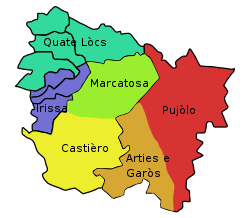Subdivisions of Catalonia
Referendums Local Catalonia, referring to the autonomous community in Spain, is territorially divided into numerous types and levels of subdivisions with varying administrative, organisational and cultural functions.
[7] Each comarca has a representative county council (Catalan: consell comarcal), except for Barcelonès, which abolished it in 2019, and Lluçanès, which, having only been established in 2023, will not have one until the 2027 local elections.
[12] The autonomous community of Catalonia is formed from the union of the four Spanish provinces (Catalan and Aranese Occitan: províncies) of Barcelona, Girona, Lleida and Tarragona.
Although the vegueries were created to replace the provinces,[5] all government, constituency and administration tasks remain constitutionally attributed to the provincial councils (Catalan: diputacions; Aranese Occitan: deputacions).
Situations like this have led some isolated municipalities to request a change of provincial boundaries from the Spanish government in order to solve problems in accessing services.
[20] Municipalities are sometimes further subdivided into: The Aran Valley, being a self-governing region within Catalonia (officially a 'unique territorial entity'; Aranese Occitan: entitat territoriau singulara; Catalan: entitat territorial singular) instead of a regular county, as well as a part of the Occitan cultural realm, represents a unique position in the Catalan regional configuration.
Originally, it was a mere additional county until the new Aranese law of 2015, which promoted this status, as well as notably recognising its symbols and anthem, giving priority to the Occitan language in administrative matters, and granting the valley the right to self-determination.
[28] The health areas (Catalan and Aranese Occitan: regions sanitàries) are an arrangement of the CatSalut [ca] service to optimise medical care for all municipalities.
They are largely similar to the functional territorial areas, with the Barcelona region being further divided into North, South and City.
[33] Following the Nueva Planta decrees, the Principality of Catalonia became a province divided into twelve Castilian corregimientos (Barcelona, Cervera, Girona, Lleida, Manresa, Mataró, Puigcerdà, Talarn, Tarragona, Tortosa, Vic and Vilafranca del Penedès) and one district (Aran).
In November 1931, a questionnaire was addressed to all municipal councils consolidating the first instance of the division of Catalonia into counties and vegueries.
The division was operational until the removal of all Catalan autonomy by the Francoist regime after the end of the Spanish Civil War.













